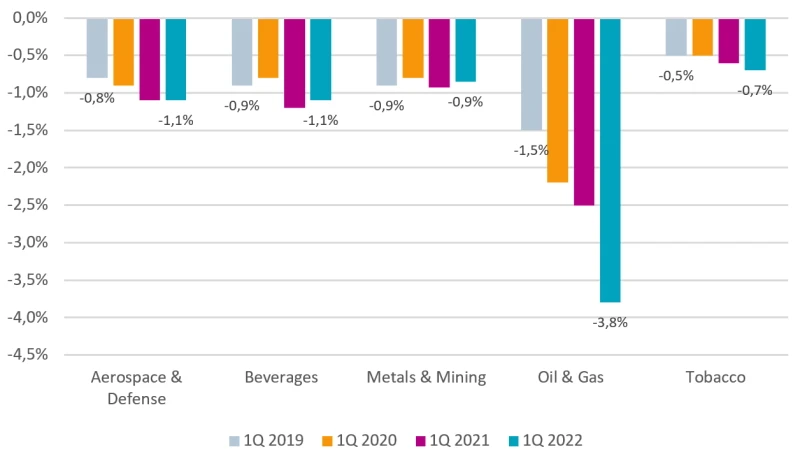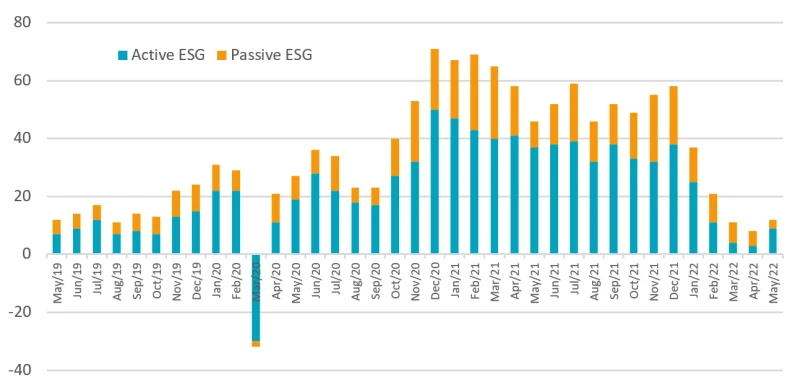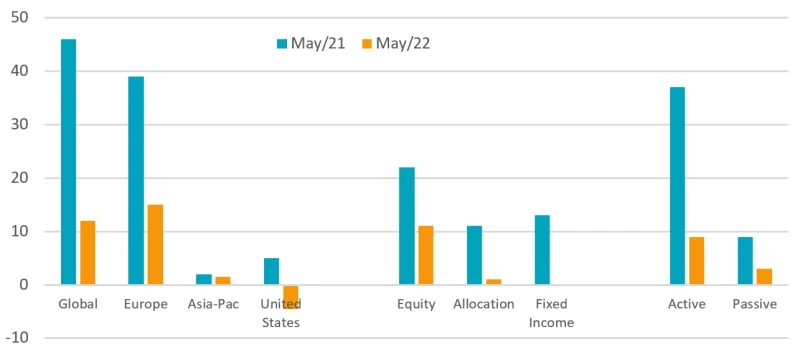Figure 1 depicts the underperformance of the headline MSCI ESG Leaders indices across the major developed market regions compared to the MSCI World market index year-to-date in 20221. Even though severe geopolitical tensions, spiking inflation and recessions fears have hurt global equity markets as a whole, the underperformance of sustainability indices has clearly been a trend change compared to previous years2.
MSCI ESG Leaders performance 2022 YTD

Source: Bloomberg. Data from 3 January to 20 June 2022. Returns are in EUR.
Market segments that have performed well, most notably fossil fuels, tobacco and defense, are commonly excluded by ESG investors, which probably explains a large part of today’s sustainability underperformance (Figures 2 and 3).
Excess performance vs. MSCI World (in EUR)

Source: Bloomberg, total return figures up 20 June 2022, in EUR.
Global ESG fund positioning in commonly excluded sectors

Source: Bernstein research, June 2022.
Recent weaker sustainability performance has without question once again sparked the debate around whether ‘doing good’ equals ‘losing money’, implying there is a natural trade-off between the two. Ideally, we want to create both wealth and well-being, but obviously sustainability strategies sometimes have competing priorities. Examples include climate concerns versus the social costs of high energy prices, or investing in defense companies during geopolitical turmoil.
The world does look different now
It is also clear that coming out of the Covid pandemic and with a war waging on the European continent, the world does look different this time – one in which sustainable investing has to evolve as well to better navigate increased market volatility.
As such, we could argue that sustainable investing is experiencing at least a ‘healthy’ reset in which mainstream assumptions about, for example, the effectiveness of strict exclusions but also ESG ratings are challenged. More sophisticated, practical approaches that apply more nuance and context will likely see increased market appetite.
The recent dwindling market appetite for sustainable investing clearly shows in fund flows too. While sustainability has been the standout story of fund flows in recent years, that trend has arguably weakened in recent months (Figure 4). For example, inflows into ESG funds stood at USD 13 billion in May 2022, which is an over 70% decline compared to the USD 46 billion from a year ago.
Global monthly ESG flows (USD billion)

Source: Morningstar, Morgan Stanley ESG research, June 2022.
Figure 5 shows a further breakdown of the drop in ESG flows across regions, asset classes and investment strategies. That said, for the first time since late 2021, inflows are ticking up again slightly, in particular for active European ESG equity strategies.
ESG fund flows by region, asset class and strategy (USD billion)

Source: Morningstar, Morgan Stanley ESG research, June 2022.
So where to go from here? Given that ESG has different colors and flavors, sustainable investing, too, is not defined in one particular way. In practice, asset owners and investors can choose the sustainability strategy most suitable to reaching their specific objectives, whether that is more impact-oriented, best-in-class ESG, exclusion-based, or more mainstream ESG integration, to name just a few. And even within each of those categories, there’s often room to maneuver in which sustainability objectives do not necessarily have to bite investment returns. The question is how?
サステナビリティに関する最新の「インサイト」を読む
ロベコのニュースレターにご登録いただくことで、いち早く最新のインサイトを入手し、環境に優しいポートフォリオの構築にお役立てください。
A barbell approach
In today’s market environment, fund managers’ fear of misaligned exposure and, conversely, desire to mitigate volatility from crowded ESG positions is high. As such, a better balance between growth and value is required. To that end, we favor an approach of owning quality companies at a reasonable price on one hand and value exposure on the other hand as an inflation hedge. In other words, owning quality businesses underpinned by strong sustainability strategies, while getting exposure to ESG improvers on the value end of the spectrum, gives flexibility whereby sustainability is not necessarily ‘sacrificing’ returns, or vice versa.
In the context of sustainable investing such a barbell approach is often referred to as “ESG integration,” something successfully explored by, for example, the Robeco Sustainable Global Stars Equities fund3. Core to this strategy is the integration of financially material ESG factors into the investment process.
In other words, sustainability that directly impacts the valuation of a company, i.e., by altering its growth outlook, profitability, risk profile or overall competitive positioning. In practice this means the strategy not only looks for high positive impact companies, but also invests in companies that are riskier as far as ESG is concerned– as long as this is also reflected in the financial model and thoroughly addressed with company management through engagement.
ESG performance attribution Sustainable Global Stars Equities

Source: Robeco research, 2022.
Sustainable investing has to evolve
Overall, every market environment brings new opportunities, also for sustainability investors. Within the wide range of sustainability strategies clearly some are more constrained than others, feeling the pain from sectors exclusions and factor exposures that until recently helped drive performance. Therefore, it becomes increasingly important to move sustainability beyond the stage of being a nice narrative alone and also stay valuation-disciplined by not overpaying for ‘good’; companies.
Going forward, we do not see the market appetite for sustainable investing suddenly disappearing. Despite seeing strong inflows for many years, still only a few percent of global assets under management are classified as ESG4, a number poised to go up over time given structural societal and regulatory support for sustainable investments5. Examples of the latter include the EU Taxonomy, a framework targeting environmentally sustainable activities, but also the EU’s more recent initiative to draft a Social Taxonomy, both of which are meant to re-direct and accelerate capital flows towards sustainable funds6. In short, despite weakening sentiment as of late, the structural underpinnings for sustainable investing still seem very much intact.
Today’s market environment, however, has taught us an important lesson; change is a constant. There is no free lunch – also sustainable investing has to advance to the next stage in its life cycle. Changing market dynamics demand a move away from simplistic, superficial sustainable approaches towards ones incorporating more forward-looking, nuanced insights and more thoughtful engagements. Ultimately, this should not only effect positive change with companies, but also make sustainable strategies more robust in navigating different, more complex market environments.
重要事項
当資料は情報提供を目的として、Robeco Institutional Asset Management B.V.が作成した英文資料、もしくはその英文資料をロベコ・ジャパン株式会社が翻訳したものです。資料中の個別の金融商品の売買の勧誘や推奨等を目的とするものではありません。記載された情報は十分信頼できるものであると考えておりますが、その正確性、完全性を保証するものではありません。意見や見通しはあくまで作成日における弊社の判断に基づくものであり、今後予告なしに変更されることがあります。運用状況、市場動向、意見等は、過去の一時点あるいは過去の一定期間についてのものであり、過去の実績は将来の運用成果を保証または示唆するものではありません。また、記載された投資方針・戦略等は全ての投資家の皆様に適合するとは限りません。当資料は法律、税務、会計面での助言の提供を意図するものではありません。 ご契約に際しては、必要に応じ専門家にご相談の上、最終的なご判断はお客様ご自身でなさるようお願い致します。 運用を行う資産の評価額は、組入有価証券等の価格、金融市場の相場や金利等の変動、及び組入有価証券の発行体の財務状況による信用力等の影響を受けて変動します。また、外貨建資産に投資する場合は為替変動の影響も受けます。運用によって生じた損益は、全て投資家の皆様に帰属します。したがって投資元本や一定の運用成果が保証されているものではなく、投資元本を上回る損失を被ることがあります。弊社が行う金融商品取引業に係る手数料または報酬は、締結される契約の種類や契約資産額により異なるため、当資料において記載せず別途ご提示させて頂く場合があります。具体的な手数料または報酬の金額・計算方法につきましては弊社担当者へお問合せください。 当資料及び記載されている情報、商品に関する権利は弊社に帰属します。したがって、弊社の書面による同意なくしてその全部もしくは一部を複製またはその他の方法で配布することはご遠慮ください。 商号等: ロベコ・ジャパン株式会社 金融商品取引業者 関東財務局長(金商)第2780号 加入協会: 一般社団法人 日本投資顧問業協会

